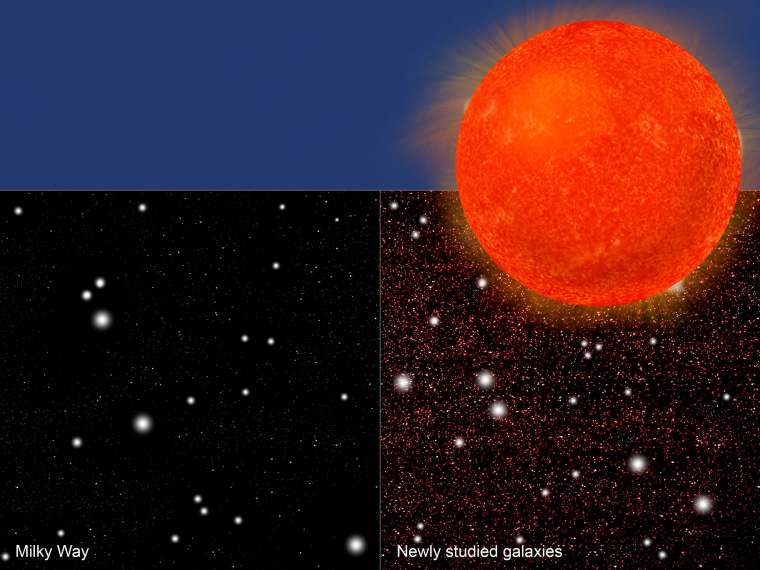The night sky may be a lot starrier than we thought.
A study suggests the universe could have triple the number of stars scientists previously calculated. For those of you counting at home, the new estimate is 300,000,000,000,000,000,000,000. That's 300 sextillion.
The study questions a key assumption that astronomers often use: that most galaxies have the same properties as our Milky Way. And that's creating a bit of a stink among astronomers who want a more orderly cosmos.
It's one of two studies being published online Wednesday in the journal Nature that focus on red dwarf stars, the most common stars in the universe. The study that offers the new estimate on stars is led by a Yale University astronomer. He calculates that there are far more red dwarfs than previously thought, and that inflates the total star count.
A second study led by a Harvard University scientist focuses on a distant "super-Earth" planet and sees clues to the content of its atmosphere — the first of this kind of data for this size planet. It orbits a red dwarf.
Red dwarf stars — about a fifth the size of our sun — burn slowly and last much longer than the bigger, brighter stars, such as the sun in the center of our solar system, said Yale astronomer Pieter van Dokkum. His study looks at how many red dwarfs are in elliptical-shaped galaxies.
When scientists had estimated previously how many stars there were in the universe, they assumed that all galaxies had the same ratio of dwarf stars as in our galaxy, which is spiral-shaped. Much of our understanding of the universe is based on observations inside our Milky Way and then extrapolated to other galaxies.
But about one-third of the galaxies in the universe are not spiral, but elliptical, and van Dokkum found they aren't really made up the same way as ours.
Using the Keck telescope in Hawaii, van Dokkum and a colleague gazed into eight other distant, but elliptical, galaxies and looked at their hard-to-differentiate light signatures. The scientists calculated that elliptical galaxies have more of those dwarf stars. A lot more.
"We're seeing 10 or 20 times more stars than we expected," van Dokkum said. By his calculations, that triples the number of estimated stars from 100 sextillion to 300 sextillion.
For the past month, astronomers have been buzzing about van Dokkum's findings, and many aren't too happy about it, said astronomer Richard Ellis of the California Institute of Technology.
Van Dokkum's paper challenges the assumption of "a more orderly universe" and gives credence to "the idea that the universe is more complicated than we think," Ellis said. "It's a little alarmist."
Ellis said it is too early to tell if van Dokkum is right or wrong, but it is shaking up the field "like a cat among pigeons."
Van Dokkum agreed, saying, "Frankly, it's a big pain."
Ellis said the new study does make sense. Its biggest weakness might be its assumption that the chemical composition of dwarf stars is the same in elliptical galaxies as in the Milky Way. That might be wrong, Ellis said. Even if it is, it would mean there are only five times more red dwarf stars in elliptical galaxies than scientists previously thought, instead of 10 or 20, van Dokkum said.
